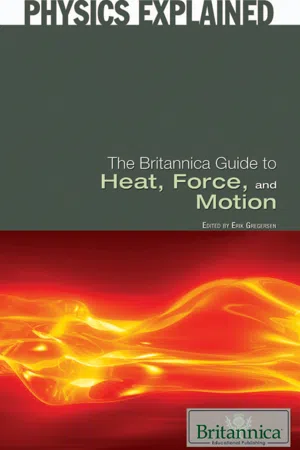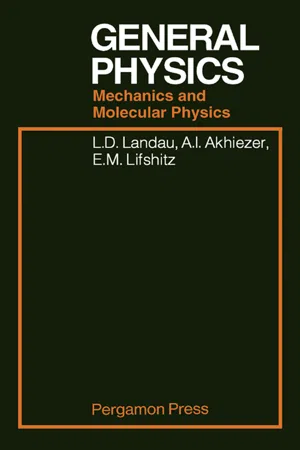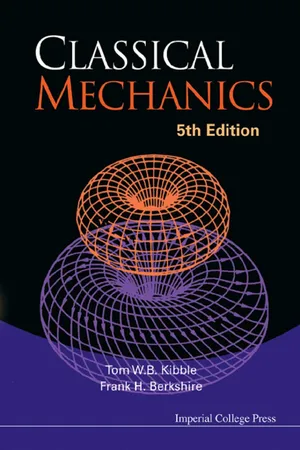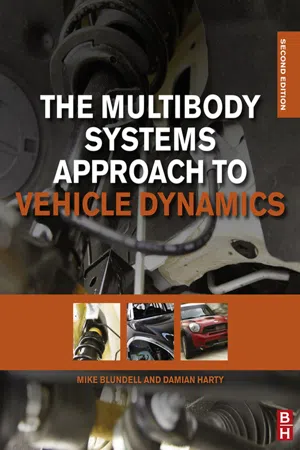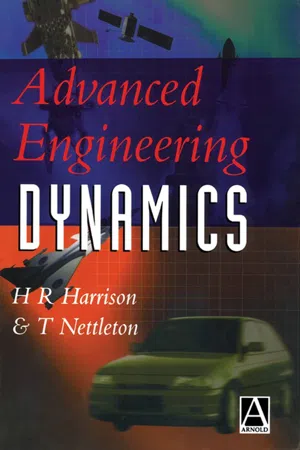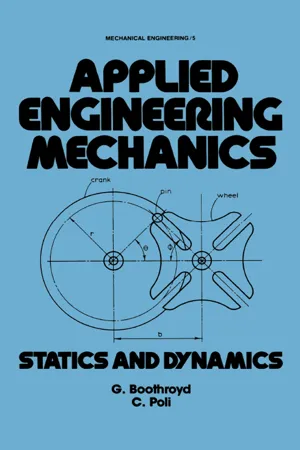Physics
Rigid Body Dynamics
Rigid body dynamics is a branch of physics that deals with the motion and forces experienced by solid objects that maintain their shape. It focuses on analyzing the movement of rigid bodies, considering factors such as rotation, translation, and the forces acting upon them. This field is essential for understanding the behavior of objects in motion and is widely used in engineering and physics.
Written by Perlego with AI-assistance
Related key terms
10 Key excerpts on "Rigid Body Dynamics"
- eBook - ePub
- Michael M. Mansfield, Colm O'Sullivan(Authors)
- 2020(Publication Date)
- Wiley(Publisher)
7 Rigid Body DynamicsAIMS
- To show how the principles governing the motion of many‐body systems, discussed in the previous chapter, can be applied to the motion of rigid bodies
- To develop a formalism for the treatment of the motion of a rigid body about a fixed axis
- To outline the formal equivalence between the principles which determine the motion of rigid bodies about a fixed axis and those which determine the motion of a point particle, as discussed in earlier chapters
- To consider the more complicated situation where the axis of rotation is not fixed, as in the case of gyroscopic motion
7.1 Rigid bodies
A rigid body is a many‐body system in which the distance between each pair of particles remains fixed, that is, the system keeps its shape despite the action of any external forces. The motion of such a system under the influence of a net external forceFEXTand of a net momentMEXTis determined by the Equations (6.5) and (6.25) which were derived in the previous chapter, namely(7.1)and(7.2)In Equation (7.1) P is the total momentum which is related toVC, the velocity of the centre of mass of the rigid body, by Equation (6.16) and hence, from Equation (6.17) ,(7.3)where ℳ is the mass of the body. Note that, in this and in some subsequent sections, the symbol ℳ is used for the mass of a body to avoid any possible confusion with the symbol for moment (M).As an example of a rigid body, consider a body of arbitrary shape, as illustrated in Figure 7.1 , which can be thought of as comprising a large number of particles of massesm1 , m2 , m3 ,… etc. If all of the body is near the Earth's surface so that g is effectively constant over its extent, then each component mass miof a body near the Earth's surface experiences a forcem. In the absence of any other external forces, the net external force on the body is given by , where is the mass of the body. The net external moment, relative to the origin O, is given byig - eBook - ePub
- Britannica Educational Publishing, Erik Gregersen(Authors)
- 2010(Publication Date)
- Britannica Educational Publishing(Publisher)
CHAPTER 5 RIGID BODIEST he previous chapter discussed mechanics in terms of particles. However, many objects are not particles but what physicists call rigid bodies. A body is formally regarded as rigid if the distance between any set of two points in it is always constant. In reality no body is perfectly rigid. When equal and opposite forces are applied to a body, it is always deformed slightly. The body’s own tendency to restore the deformation has the effect of applying counterforces to whatever is applying the forces, thus obeying Newton’s third law. Calling a body rigid means that the changes in the dimensions of the body are small enough to be neglected, even though the force produced by the deformation may not be neglected.STATICS
Statics is the study of bodies and structures that are in equilibrium. For a body to be in equilibrium, there must be no net force acting on it. In addition, there must be no net torque acting on it.When a body has a net force and a net torque acting on it owing to a combination of forces, all the forces acting on the body may be replaced by a single (imaginary) force called the resultant, which acts at a single point on the body, producing the same net force and the same net torque. The body can be brought into equilibrium by applying to it a real force at the same point, equal and opposite to the resultant. This force is called the equilibrant.(A) A body in equilibrium under equal and opposite forces. (B) A body not in equilibrium under equal and opposite forces . Copyright Encyclopædia Britannica; rendering for this edition by Rosen Educational ServicesThe resultant force ( F R ) produces the same net force and the same net torque about point A as F 1 + F 2 ; the body can be brought into equilibrium by applying the equilibrant forceFe - eBook - ePub
Stress, Strain, and Structural Dynamics
An Interactive Handbook of Formulas, Solutions, and MATLAB Toolboxes
- Bingen Yang(Author)
- 2005(Publication Date)
- Academic Press(Publisher)
Section 9.6 .9.2 Dynamics of Particles
9.2.1 PreliminariesUnits
Some commonly used quantities in engineering mechanics are listed in Table 9.2.1 , where units in both the Standard International (SI) and U.S. Customary Systems are shown.TABLE 9.2.1 UnitsNewton’s Laws
Classical mechanics was established based upon the following three laws of motion that were first stated by Isaac Newton in 1687:First Law: A particle remains at rest or moves with a constant velocity along a straight line if the sum of the forces acting on it is zero.Second Law: The rate of change of the linear momentum of a particle is equal to the sum of the forces acting on it.Third Law: The forces exerted by two particles upon each other, which are called the action and reaction forces, are equal in magnitude, opposite in direction, and collinear.Mathematically, Newton’s second law is expressed by(9.1)where m and ν are the mass and velocity of the particle, respectively; F is the resultant or sum of all forces acting on the particle; and mv is the linear momentum of the particle. If the mass m is constant, Eq. (9.1) becomes(9.2)where is the acceleration of the particle. Equation (9.2) is a commonly used expression of Newton’s second law, which indicates that the acceleration of a particle of constant mass is proportional to the resultant force.Besides Newton’s laws of motion, Newton’s law of gravitation is also important in dynamics, especially in orbital dynamics; see Sec. 9.2.6 .Force
The motion of a particle or body is caused by forces. A force is an action of pull or push applied by one body to another. A force is characterized by its magnitude, direction of action, and point of application. Thus, forces can be expressed by vectors, and superposition of forces follows the parallelogram rule of vector summation. For instance, the sum of forces F 1 and F 2 in Fig. 9.2.1(a) is obtained by the diagonal of the parallelogram formed by the forces, as shown in Fig. 9.2.1(b) - eBook - ePub
General Physics
Mechanics and Molecular Physics
- L D Landau(Author)
- 2013(Publication Date)
- Pergamon(Publisher)
CHAPTER IIIMOTION OF A RIGID BODY
Publisher Summary
This chapter discusses some types of motion of a rigid body. In mechanics, rigid body means that the relative position of the parts of a body remains unchanged during the motion. The body, thus, moves as a whole. The simplest motion of a rigid body is one in which it moves parallel to itself; this is called translation. For example, if a compass is moved smoothly in a horizontal plane, the needle will retain a steady north-south direction and will execute a translational motion. In translational motion of a rigid body, every point in it has the same velocity and describes a path of the same shape, there being merely a displacement between the paths. Another simple type of motion of a rigid body is rotation about an axis. The chapter describes the energy of a rigid body in motion, rotational angular momentum, gyroscope, and inertia forces.§25. Types of motion of a rigid body
So far we have considered the motion of bodies which might be regarded as particles under certain conditions. Let us now go on to consider motions in which the finite size of bodies is important. Such bodies will be assumed to be rigid . In mechanics, this term means that the relative position of the parts of a body remains unchanged during the motion. The body thus moves as a whole.The simplest motion of a rigid body is one in which it moves parallel to itself; this is called translation . For example, if a compass is moved smoothly in a horizontal plane, the needle will retain a steady north-south direction and will execute a translational motion.In translational motion of a rigid body, every point in it has the same velocity and describes a path of the same shape, there being merely a displacement between the paths.Another simple type of motion of a rigid body is rotation about an axis. In rotation, the various points in the body describe circles in planes perpendicular to the axis of rotation. If in a time dt the body rotates through an angle dφ , the path ds traversed in that time by any point P of the body is clearly ds = r dφ , where r is the distance of P from the axis of rotation. Dividing by dt , we obtain the velocity of P - eBook - ePub
- Tom W B Kibble, Frank H Berkshire(Authors)
- 2004(Publication Date)
- ICP(Publisher)
Chapter 9Rigid BodiesThe principal characteristic of a solid body is its rigidity. Under normal circumstances, its size and shape vary only slightly under stress, changes in temperature, and the like. Thus it is natural to consider the idealization of a perfectly rigid body, whose size and shape are permanently fixed. Such a body may be characterized by the requirement that the distance between any two points of the body remains fixed. In this chapter, we shall be concerned with the mechanics of rigid bodies.9.1Basic PrinciplesIt will be convenient to simplify the notation of the previous chapter by omitting the particle label i from sums over all particles in the rigid body. Thus, for example, we shall writein place of (8.3) and (8.11). The motion of the centre of mass of the body is completely specified by (8.6):Our main interest in this chapter will be centred on the rotational motion of the rigid body. For the moment, let us assume, as we originally did in §8.3 , that the internal forces are central. Then, according to (8.14),We shall see later that these two equations are sufficient to determine the motion completely.One very important application of (9.1) and (9.2) should be noted. For a rigid body at rest, = 0 for every particle, and thus both P and J vanish. Clearly, the body can remain at rest only if the right hand sides of both (9.1) and (9.2) vanish, i.e., if the sum of the forces and the sum of their moments are both zero. In fact, as we shall see, this is not only a necessary, but also a sufficient, condition for equilibrium.Under the same assumption of central internal forces, we saw in §8.5 that the internal forces do no work, so thatThis might at first sight appear to be a third independent equation. However, we shall see later that it is actually a consequence of the other two. It is of course particularly useful in the case when the external forces are conservative, since it then leads to the conservation law - Michael Blundell, Damian Harty(Authors)
- 2014(Publication Date)
- Butterworth-Heinemann(Publisher)
Chapter 2Kinematics and Dynamics of Rigid Bodies
Abstract
Chapter 2 is included for completeness and covers the underlying formulations in kinematics and dynamics required for a good understanding of multibody systems formulations. A three-dimensional vector approach is used to develop the theory, this being the most suitable method for developing the rigid body equations of motion and constraint formulations described later.Keywords
Acceleration analysis; Dynamics of a particle; Equations of motion; Geometry analysis; Static force and moment definition; Theory of vectors; Velocity analysisMy God, it's full of stars! Dave Bowman, 2001: A Space Odyssey2.1. Introduction
The application of a modern multibody systems (MBS) computer program requires a good understanding of the underlying theory involved in the formulation and solution of the equations of motion. Due to the three-dimensional nature of the problem the theory is best described using vector algebra. In this chapter the starting point will be the basic definition of a vector and an explanation of the notation that will be used throughout this text. The vector theory will be developed to demonstrate, using examples based on suspension systems, the calculation of new geometry and changes in body orientation, such as the steer change in a road wheel during vertical motion relative to the vehicle body. This will be extended to show how velocities and accelerations may be determined throughout a linked three-dimensional system of rigid bodies. The definition of forces and moments will lead through to the definition of the full dynamic formulations typically used in a MBS analysis code.2.2. Theory of vectors
2.2.1. Position and relative position vectors
- eBook - ePub
- H. Harrison, T. Nettleton(Authors)
- 1997(Publication Date)
- Butterworth-Heinemann(Publisher)
4Rigid Body Motion in Three Dimensions
4.1 Introduction
A rigid body is an idealization of a solid object for which no change in volume or shape is permissible. This means that the separation between any two particles of the body remains constant.If we know the positions of three non-colinear points, i, j and k , then the position of the body in space is defined. However, there are three equations of constraint of the form |ri −rj| = constant so the number of degrees of freedom is 3 × 3 − 3 = 6.4.2 Rotation
If the line joining any two points changes its orientation in space then the body has suffered a rotation. If no rotation is taking place then all particles will be moving along parallel paths. If the paths are straight then the motion is described as rectilinear translation and if not the motion is curvilinear translation. From the definitions it is clear that a body can move along a circular path but there need be no rotation of the body.It follows that for any pure translational motion there is no relative motion between individual particles. Conversely any relative motion must be due to some rotation.The rotation of a rigid body can be described in terms of the motion of points on a sphere of radius a centred on some arbitrary reference point, say i . The body, shown in Fig. 4.1 , is now reorientated so that the points j and k are moved, by any means, to positions j′ and k′ . The arc of the great circle joining j and k will be the same length as the arc joining j′ and k′, by definition of a rigid body. Next we construct the great circle through points j and j′ and another through the points k and k′ . We now draw great circles which are the perpendicular bisectors of arcs jj′ and kk′ . These two circles intersect at point N. The figure is now completed by drawing the four great circles through N and the points j, k, j′ and k′ respectively.Fig. 4.1By the definition of the perpendicular bisector arc Nj = arc Nj′ and arc Nk = arc Nk′ . Also arc jk = arc j′k′ and thus it follows that the spherical triangle k Nj is congruent with k′ Nj′ . Now the angle k Nj = k′ Nj′ and the angle k Nj′ is common; therefore angle k Nk′ = j Nj′ - eBook - ePub
- John Chiasson(Author)
- 2022(Publication Date)
- Wiley(Publisher)
5 Rigid Body Rotational Dynamics 5.1 Moment of Inertia The equation s of motion of a rigid body that is constrained to rotate about a fixed axis are reviewed here briefly. Consider the cylinder shown in Figure 5.1. Figure 5.1 Cylinder constrained to rotate about a fixed axis. The approach here is to obtain the equations of motion of the cylinder by first obtaining an expression for its kinetic energy. To do so, denote the angular speed of the cylinder by and the mass density of the material making up the cylinder by. Then consider the cylinder to be made up of a large number of small pieces of material where the th piece has mass This is illustrated in Figure 5.2. Each piece of mass is rotating at the same angular speed so that the linear speed of is where is the distance of from the axis of rotation. The kinetic energy of is given by Figure 5.2 Cylinder is considered to be made up of small masses The total kinetic energy is then Dividing the cylinder into f iner and finer pieces so that and, the sum becomes the integral The quantity is called the moment of inertia. Using the kinetic energy of the cylinder may now be written as Taking the axle radius to be zero, the moment of inertia of the cylinder (assuming the mass density is constant) is computed to be where is the total mass of the cylinder. 5.2 Newton's Law of Rotational Motion The kinetic energy is now used to derive a relationship between torque and angular acceleration. Recall from elementary mechanics that the work done on a mass by an external force equals the change in its kinetic energy - eBook - ePub
Applied Engineering Mechanics
Statics and Dynamics
- C. Poll, G. Boothroyd(Authors)
- 2018(Publication Date)
- Routledge(Publisher)
17 Dynamics of Rigid Bodies 17.1 IntroductionIn the previous three chapters, the motion of particles due to the application of external forces was studied. There, each body was assumed to be either infinitesimally small so that its mass and all the external forces acting were concentrated at the same point, or the orientation of the body in space was unimportant so that it was not necessary to take into account the body’s shape or the exact location of the forces. In this chapter, we shall be concerned with a study of the relationships between the forces that act on any rigid body and the corresponding translational and rotational motions of the body.Only two equations of motion are needed to determine either the planar motion of a single particle or the planar motion of the center of mass of a group of particles. For the planar motion of a rigid body, an additional equation of motion is needed in order to determine the rotational motion of the body.17.2 Planar Motion of a Rigid BodyFigure 17.1a shows the free-body diagram for a rigid body moving in the xy plane. Since a rigid body is merely a collection of particles with no relative linear motion between them, the motion of the center of mass of the body can be determined from the translational equations of motion in the x and y directions as follows:Fig. 17.1 Rigid body with planar motion.F x= ma= mc xx ¨c(17.1) F y= ma= mc yy ¨c(17.2) where m is the total mass of the body; Fx and Fy are the sums of the components of the external forces in the x and y direction, respectively; and acx and acy are the components of the acceleration of the center of mass in these two directions, respectively.To develop the rotational equation of motion, we can examine first the motion of a single particle of mass mp located at P (Fig. 17.1b ). This motion consists of the rotation of point P about the center of mass C superimposed on the motion of the center of mass. Thus, the total inertia forces for the particle will be the sum of the individual inertia force components shown in the two diagrams in Fig. 17.1b . Now if Fex and Fix represent the x components of the external and internal forces acting on the particle, respectively, and Fey , Fiy represent the y components, the free-body diagram for the particle will be as shown in Fig. 17.1c . Taking moments about C and equating the moments of the forces in Fig. 17.1c to the sum of the moments of all the individual inertia forces in Fig. 17.1b - eBook - ePub
- Sir James H. Jeans(Author)
- 2013(Publication Date)
- Dover Publications(Publisher)
CHAPTER XIMOTION OF RIGID BODIES
229. The present chapter is devoted to a discussion of the motion of rigid bodies, when the motion is such that the bodies may not be treated as particles.It has already been proved in § 66 that the most general motion possible for a rigid body is one compounded of a motion of translation and a motion of rotation. As a preliminary to discussing the general motion of a rigid body under the action of forces of any description, we shall examine in greater detail than has so far been done the properties of a motion of rotation.ANGULAR VELOCITY
230. We have seen (§ 67) that for every motion of a rigid body in which a point P remains fixed, there is an axis of rotation, which is a line passing through P , of which every point remains fixed. If a rigid body is moving continuously we may analyze its motion in the following way. We select a definite particle P of the rigid body, and we refer the motion to a frame of reference having P as origin, and moving so as always to remain parallel to its original position. Relative to this frame, the motion of the body between any two instants is a motion of rotation about P
Index pages curate the most relevant extracts from our library of academic textbooks. They’ve been created using an in-house natural language model (NLM), each adding context and meaning to key research topics.

